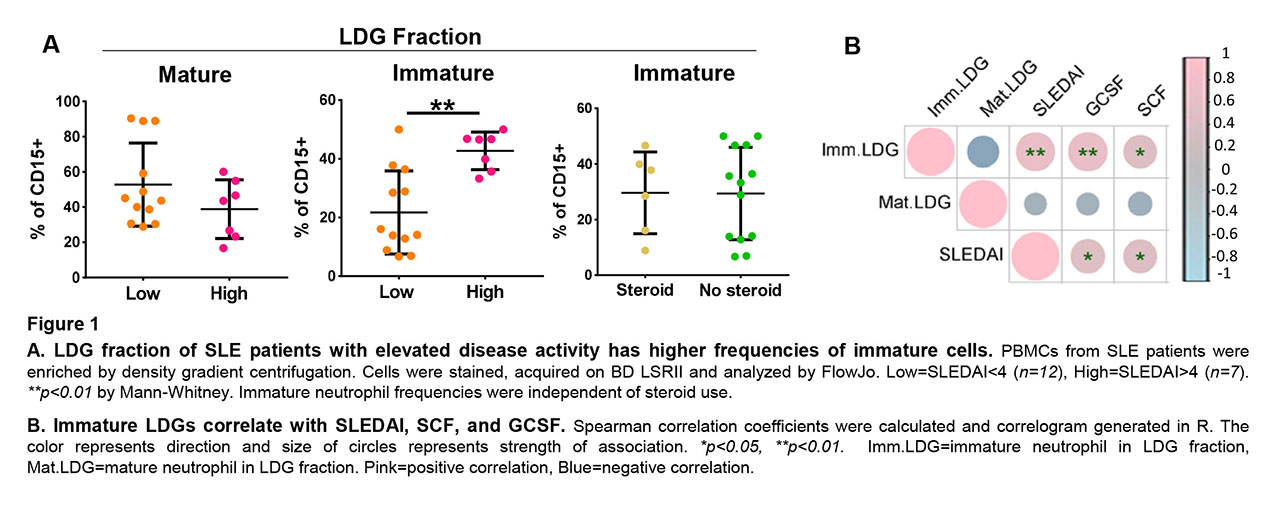Session Information
Session Type: Poster Session (Tuesday)
Session Time: 9:00AM-11:00AM
Background/Purpose: Systemic lupus erythematosus (SLE) is a systemic autoimmune disease characterized by autoantibody production and periods of elevated disease activity. Recent studies indicate that along with dysfunctional adaptive immune responses, neutrophils are also important in disease pathogenesis. SLE patients have higher numbers of low-density granulocytes (LDGs) in peripheral blood that express neutrophil markers and are hyper-responsive to external stimuli. LDGs also have an enhanced ability to form neutrophil extracellular traps (NETs), and are suggested to be pathogenic in lupus. This study was carried out to determine whether the LDG fraction consists of immature cells and whether these cells differ with disease activity.
Methods: Peripheral blood mononuclear cells from 19 SLE patients with varying disease activity and 11 controls were enriched by density gradient centrifugation. Neutrophils were enriched by dextran sedimentation and density gradient centrifugation. LDG numbers were determined by flow cytometry. Plasma cytokines were measured by xMAP assays. Neutrophils were cultured for 3h and cytokines in supernatants were measured by xMAP assays. Levels of microRNA (miRNA) were determined by quantitative PCRs. SLE disease activity indices (SLEDAI) were obtained from medical records. Immature and mature neutrophil frequencies in bone marrow from 9-11 months old B6.NZM/Sle1/Sle2/Sle3 (Sle123) or C57BL/6J (B6) mice were determined by flow cytometry.
Results: SLE patients with elevated disease activity had significantly higher frequency of immature LDGs as determined by surface marker expression (p=0.0053) (Figure 1A). The frequencies of immature LDGs correlated with the SLE disease activity index (SLEDAI) and plasma G-CSF (Spearman r=0.651, p=0.0025, r=0.663, p=0.002, respectively) (Figure 1B). Compared to their wild type B6 counterpart, the spontaneous lupus mice Sle123 showed increased immature neutrophils (p=0.0079), similar to our data from lupus patients. SLE neutrophils spontaneously secreted higher levels of BAFF (p=0.043) and IL-21 (p=0.0394), but not IL-8 or MMP9. SLE neutrophils expressed significantly different levels of select miRNA compared to healthy neutrophils, as was previously reported for neutrophils generated by G-CSF induced emergency granulopoiesis.
Conclusion: Our data suggest that SLE patients may have dysregulated development of myeloid cells in the bone marrow due to the cytokine milieu present during elevated disease activity. The functional responses of these newly generated neutrophils may differ due to differences in the bone marrow transit time. The dysregulation of granulopoiesis therefore may generate neutrophils that further exacerbate autoimmune response.
To cite this abstract in AMA style:
Jog N, Aberle T, Arriens C, Gallucci S, James J. Dysregulation of Granulopoiesis in Systemic Lupus Erythematosus [abstract]. Arthritis Rheumatol. 2019; 71 (suppl 10). https://acrabstracts.org/abstract/dysregulation-of-granulopoiesis-in-systemic-lupus-erythematosus/. Accessed .« Back to 2019 ACR/ARP Annual Meeting
ACR Meeting Abstracts - https://acrabstracts.org/abstract/dysregulation-of-granulopoiesis-in-systemic-lupus-erythematosus/

